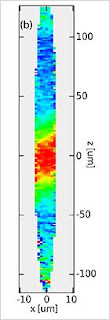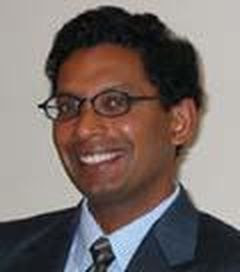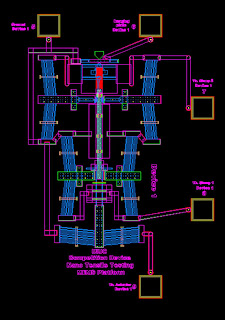Electrical Engineering Grad Student Racks Up Awards
 | San Diego, CA, May 14, 2007 -- For his work on how semiconducting nanowires grow and behave, Shadi A. Dayeh, a graduate student in the Department of Electrical and Computer Engineering (ECE) at the UCSD Jacobs School of Engineering, has recently earned a series of awards. |
As LEDs, photovoltaics, biological and chemical sensors, nano-pipes for optical communications, and other applications, nanowires – crystalline fibers about one thousandth the width of a human hair – hold great promise. But there are many fundamental questions regarding how nanowires work and how they will perform in stressful, real-world conditions that need to be understood before nanowires get the chance to live up to the expectations. Shadi Dayeh, a Ph.D. candidate who works in the UCSD electrical engineering laboratories of both Deli Wang and Edward Yu, is deeply involved in this fundamental work on nanowires. Dayeh’s contributions are now being recognized by leaders in the field.
 | In March 2007, Dayeh learned that he won one of three best paper awards at the 2006 Electronic Materials Conference (EMC). Then, at the Materials Research Society (MRS) Spring meeting this April, Dayeh took home two more awards: the graduate student “silver medal” award |
for his body of research on the synthesis and fabrication of compound semiconducting nanowires and devices for novel electronics; and a best poster award for research on field-, diameter-, and surface state- dependent transport behavior in semiconducting nanowires. In January 2007, Dayeh also received a Young Scientist Award at the 34th Conference on the Physics & Chemistry of Semiconductor Interfaces (PCSI-34).
In his award winning paper at EMC 2006, Dayeh helped to resolve a debate regarding which mechanism governs the growth of an important class of nanowires – the III-V compound semiconducting nanowires.
| Dayeh and a team of electrical engineers from the Jacobs School demonstrated that the vapor-liquid-solid (VLS) growth mechanism that was proposed in 1964 does, in fact, extend to III-V compound semiconducting nanowires – a group that includes indium arsenide (InAs) nanowires. |  |
This is noteworthy because, recently, researchers have claimed that III-V compound semiconducting nanowires grow via the vapor-solid-solid (VSS) growth mechanism.
“Shadi’s work not only improves our understanding of three-five nanowire growth, but it also opens the door to a wider tuning range of temperature and precursor flow rates to control nanowire growth rates, morphology, and material properties,” said Deli Wang.
| The recent reports that the vapor-liquid-solid growth mechanism did not extend to III-V compound semiconducting nanowires left Dayeh unconvinced. After replicating the findings, he and the rest of the Jacobs School team tapped their understanding of the fundamental science of how nanowires grow and began experimenting. |  |
“As the temperature increases, we know that the molar fraction of the group five element increases with respect to that of the group three element. This enhances thin-film growth and minimizes nanowire growth,” said Dayeh, who wondered if this could explain the reports that nanowire lengthening stopped when the growth temperature reached a certain critical value. This temperature was thought to be the melting temperature of the group III-Au alloy, typically employed in III-V compound nanowire growth.
Following this train of thought, Dayeh began tinkering with the initial molar ratios of the group III and group V precursor materials for InAs nanowires – tri-methyl-indium [In(CH3)3]and arsine [AsH3], respectively.
By starting with lower arsine concentrations, Dayeh demonstrated that III-V compound semiconducting nanowire growth prevails at higher temperatures according to the vapor-liquid-solid growth mechanism. He confirmed that the cessation of nanowire growth at certain high temperatures was tied to an imbalance in the molar ratios of the starting ingredients and not to a halted vapor-solid-solid growth mechanism.
Dayeh’s work on nanwires is broad in scope.
“My very recent work has shown that nanowires grown at different temperatures and in different crystallographic orientations exhibit notably different electronic properties,” said Dayeh.
In the work presented at the MRS 2007 spring meeting, Dayeh and colleagues at the Jacobs School performed a systemic study of carrier transport properties in InAs nanowire field effect transistors. This kind of research enables the understanding of important physical phenomena at the nanoscale and provides basic parameters for the design and fabrication of functional devices and integrated systems. The experimental studies include device scaling and miniaturization effects on performance as well as transport behavior and morphological changes when exposed to high applied electric fields. Among other implications, this line of research has highlighted thermal management as an important issue in realizing the full potential of nanowire-based devices
In work published online by the journal APPLIED PHYSICS LETTERS (selected by Virtual Journal of Nanoscale Science and Technology), Dayeh and a team of Jacobs School electrical engineers fabricated InAs nanowire field effect transistors (NWFETs) and investigated the capacitive effects of surface states on the field effect transistor (FET) transport properties. This analysis may help explain the wide range of nanowire parameters reported in the literature, which indicates that measurements at slow sweep rates enable a dynamic equilibrium of surface state charging and discharging and allow the extraction of the intrinsic nanowire transport parameters. This analysis also highlights the potential of InAs nanowires for high speed electronics with effective surface passivation.
In an earlier publication in the Journal of Vacuum Science and Technology B, Dayeh and Xiaotian Zhou, a graduate student in the UCSD materials science program who is advised by Edward Yu, observed room temperature ballistic transport in InAs nanowires over lengths up to ~200nm, another indication of the promise of this material.
“Shadi's studies of transport phenomena in InAs nanowires are helping to establish the foundation for the application of these materials in future high-performance electronic devices and circuits,” said Edward Yu.
In addition, the journal Small recently published research by Dayeh and colleagues at the Jacobs School demonstrating the promising potential of using InAs nanowires for high-speed nanoelectronics and providing analysis that enables accurate parameter extraction from such devices. In particular, the electrical engineers fabricated and characterized underlap top-gate and global back-gate InAs NWFETs, and demonstrated the highest semiconductor nanowire electron mobility reported to date.
“As a co-author on this paper, I experienced Shadi’s sharp intellect, creativity and sensitivity to detail. Shadi certainly exemplifies one of the great aspects of our ECE department. This is a place where students are challenged to solve some of the most pressing engineering questions of our time,” said Paul Yu, chair and professor, Department of Electrical and Computer Engineering, Jacobs School of Engineering .
Dayeh is also part of a broad collaboration of researchers at the Jacobs School that has recently reported breakthroughs in p-type ZnO nanowire synthesis and high sensitivity ZnO nanowire photodetectors, both published in Nano Letters and highlighted in the technology press.
Further information can be found at the Nano-Electronics, Photonics and Medicine and Nanoscale Characterization and Devices Laboratory websites.
Nano-Electronics, Photonics and Medicine (Deli Wang lab)
Nanoscale Characterization and Devices Laboratory (Edward Yu lab)
Funders: Office of Naval Research (ONR-Nanoelectronics), the National Science Foundation (NSF), Sharp Labs of America.
Dayeh and colleagues also recognize the staff of Calit2’s Nano3 Facility for maintenance of the nanofabrication environment.
Shadi Dayeh’s Recent Awards:
EMC 2006 best paper award: “Growth Mechanism and Optimization of InAs Nanowires Synthesized by OMVPE,” by Shadi A. Dayeh, David Aplin, Edward T. Yu, Paul K.L. Yu, and Deli Wang. All authors are from the Department of Electrical and Computer Engineering, UC San Diego Jacobs School of Engineering.
Spring MRS 2007 best poster award: “Field-, Diameter-, and Surface State- Dependent Transport Behavior in Semiconductor Nanowires,” by Shadi A. Dayeh, Paul K. L. Yu, Edward T. Yu, and Deli Wang. All authors are from the Department of Electrical and Computer Engineering, UC San Diego Jacobs School of Engineering.
Spring MRS 2007 Graduate Student Award: Silver Medal. PCSI-34 2007 Young Scientist Award.
Technorati Tags:
nanofibers or
Nanoscientists and
Nano or
Nanotechnology and
nanoparticles or
Nanotech and
nanotubes or
nanochemistry and
nanoscale or
Nanoelectronics or
UCSD Jacobs School of Engineering and
Semiconductor Interfaces or
III-V compound semiconducting nanowires and
Nanotechnology Today or
Public Domain Clip Art and
Republican National Convention Blog


































